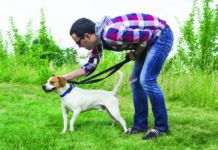We wanted to show a photo of Gracie the Bassett hound with her new owner, Mike Phillips. But that would have been impossible, reports Mr. Phillips’s wife, Beth. Gracie won’t go near him. She is “terrified of him,” Mrs. Phillips says. “She stalks him when he is moving around, barking non-stop,” but as soon as he comes towards her, “she shies away from him and runs.”

Mr. Phillips has tried giving Gracie treats when he walks past her, ignoring her completely when she barks, and reassuring her when she is frightened. But nothing, absolutely nothing, seems to help. “My husband really wants to love this little girl,” Mrs. Phillips remarks, but “we don’t want her in a situation that stresses her out so much. Is there a solution?”
We think there is. But first, a little on Gracie’s background.
Gracie’s life before she arrived at the Phillips’
“We think Gracie is about 6 years old,” Mrs. Phillips says. “We suspect she was used in a breeding mill. She and her cohort Grover were found wandering along the road near the Florida/Georgia border. He was still intact, and she had obviously had puppies. Also, she had not been spayed yet.
“Someone had dumped them,” Mrs. Phillips continues. “They were thin and very bonded. We adopted them as a bonded pair last June. We had room, and they had an emergency situation. The lady who had been fostering them had a change in work that left her with almost 4 hours of commuting daily. She did not want to leave them confined for many hours every day. So we took them after seeing them on the Facebook page of Sun Coast Basset Rescue in Florida. We have rescued a lot of animals over the years.
“We fell in love with them both. For the first couple of months, they hardly ever went anywhere without each other and frequently slept together in the same bed. But between gaining weight and feeling safer, they’re much more independent of each other now.

“Grover, he’s fine. He had some weakness in his back legs that the rescue suspected was from being confined in a cage for quite a while. Some of his front teeth are missing, maybe from chewing on the bars of the cage trying to get out. Like Gracie, however, he has gained weight and both are also much stronger now. Grover would just fall down when we first got him, but he has definitely improved with having free reign and exercise. He’s just a love bug.
“But,” says Mr. Phillips, “Gracie was afraid of me from the get-go.”
The foster “mom” had told the Phillips that Gracie was very shy around people in general, but she bonded to Mrs. Phillips immediately. Yet there has been no improvement with Mr. Phillips since she arrived at their home many months ago — a particular surprise, Mrs. Phillips says, “because Mike has always been the Dr. Doolittle of animals.” Yet Gracie “looks at Mike like she’s never seen him before,” Mrs. Phillips remarks, “barking and backing away. If he comes into a room, she will dart out, watching him the whole time. He can throw a treat to her, but she won’t take it out of his hand. When I leave the house to run errands, she barks most of the time I am gone. I’ve never seen a dog with a more worried look.”
“Fretful,” Mr. Phillips calls it.
“We want her to be happy and to feel safe,” Mrs. Phillips says. “If she’s unhappy in her house, we don’t want her to feel trapped. We are definitely willing to put the time in.”
The good news is that with time, Gracie’s prospects with Mr. Phillips are good.
An animal behaviorist weighs in
“I have seen a good few patients like Gracie,” comments Stephanie Borns-Weil, DVM, who helps troubled pets in Tufts’s Animal Behavior Clinic. “It’s a common enough problem with dogs who have been mistreated or neglected during their sensitive period of learning [roughly the third through the twelfth week of life]. They often come from similar backgrounds — rescue backgrounds — and have a fear of one of their owners. It is a tough problem. But most of the time we can figure it out. It just takes a long time — and a dedicated and persistent owner,” which, fortunately, Mr. Phillips is.
“What we’re looking at with a lot of these dogs is PTSD,” or post-traumatic stress disorder, says Dr. Borns-Weil. That is, it’s often a dog “who has been hurt in the past.
“Dogs have very good memories,” she says. “And in addition to having good memories, they’re superstitious. If something happened in the company of someone, even if that person didn’t cause the bad thing to happen, the dog might assume that all people who remind her of the person who was present at the time of an unfortunate event (like accidentally tripping over the dog) are going to make another unfortunate event occur. “Some dogs are not resilient” enough to allow that an accident or mistake was just that and nothing more.
“But you can get there,” Dr. Borns-Weil believes. The key to desensitizing a traumatized dog is patience and a very, very slow pace. You can only go as fast as the dog will. “One person I worked with, it was 10 months before this dog — a rescue dog who also didn’t like the husband — experienced a turn-around,” she says.
Implementing a plan
Fortunately, the steps Mr. Phillips has already been taking are the correct ones. “I think he’s doing the right things,” Dr. Borns-Weil says. “Truly ignoring the dog for a while,” as he does, “can be really helpful.” It lets the dog decide when it’s time to socialize. “Dropping treats without actually trying to hand them to the dog is a good strategy, too,” she comments. But there are other things Mr. Phillips can try with Gracie as well.
Accompany Mrs. Phillips and Gracie on walks. “Just being a quiet presence when good things are happening” — like being taken outside — can be very effective for making a dog feel calmer in the presence of someone of whom she’s afraid. After several weeks, Mrs. Phillips may even be able to “hand over the reins” to Mr. Phillips.
Be the one to put Gracie’s food in her bowl sometimes. That shows Gracie that Mr. Phillips is looking out for her needs, not just Mrs. Phillips.
See if Gracie is more comfortable interacting when Grover is around. “It’s worth noting that some dogs are more comfortable in the company of other dogs rather than people,” Dr. Borns-Weil says. “If that’s the case, that would be a good time to try to interact.”
Note whether there’s a time of day that the dog might be more open to interacting. In Gracie’s case, it so happens there is. In the morning, when she is just waking up, she lets Mr. Phillips approach her and pet her. That might be a wonderful time to offer Gracie her favorite food treat, perhaps a morsel of delectable cheese or a tiny piece of beef. Or maybe she has a favorite toy that she would like brought to her by Mr. Phillips upon rising in the a.m.
Sit. If Mr. Phillips is seated, Gracie will allow him to pet her and talk to her — although she remains wary. It’s not surprising when you consider that Mr. Phillips is 6 feet 4 inches — tall by any reckoning. “We assume his size must trip some kind of trigger for her,” Mrs. Phillips says. It’s a reasonable supposition, and to make the most of it, Mr. Phillips should offer Gracie favorite toys and treats from a chair or couch rather than from a standing position. That might eventually lead to his standing in her presence without her feeling nervous.
Speak soothingly. Dogs often feel reassured by voices that are spoken softly and with warmth and friendliness. Mr. Phillips has a pleasant
soft voice in the first place, but if he spoke especially soothingly and reassuringly, and at turns enthusiastically, to Gracie, she might respond more positively. He does not need to raise his voice an octave or two or talk baby talk. In fact, Dr. Borns-Weil counsels people to avoid baby talk unless they know in advance that it proves calming for their particular dog. Unusual voices can sometimes prove fear-inducing to already-fearful dogs.
When all else fails, medication
“Sometimes,” Dr. Borns-Weils says, “for dogs who are very severely affected with underlying anxieties and abuse histories, medication can be useful in paving the way for some bonding. She mentions SSRIs (serotonin reuptake inhibitors) like Prozac (fluoxetine) or Zoloft (sertraline) along with Buspar (buspirone), which is an anxioselective drug that decreases anxiety without causing sedation or psychomotor impairment. “These drugs can put a dog’s anxiety enough in the background that a person can start to interact with his pet,” she says. “It helps a dog get to the point that she can be receptive to behavioral modifications someone is trying to putin place.
“It’s a long road and slow going,” Dr. Borns-Weil reminds. “It takes patience. Sometimes it can be really hard for owners not to get their feelings hurt.” But if they can stay the course without trying to go too quickly (that’s called “flooding” and does not work with dogs), the chances for eventual bonding success are high.
“Knowing that it may take as many as 10 months is reassuring,” Mrs. Phillips says. “We are dedicated to working this out.” Mr. Phillips feels the same way. We will check back in a few months to see how Gracie and he are doing. n





